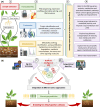Transcriptomics, proteomics, and metabolomics interventions prompt crop improvement against metal(loid) toxicity
- PMID: 38411713
- PMCID: PMC10899315
- DOI: 10.1007/s00299-024-03153-7
Transcriptomics, proteomics, and metabolomics interventions prompt crop improvement against metal(loid) toxicity
Abstract
The escalating challenges posed by metal(loid) toxicity in agricultural ecosystems, exacerbated by rapid climate change and anthropogenic pressures, demand urgent attention. Soil contamination is a critical issue because it significantly impacts crop productivity. The widespread threat of metal(loid) toxicity can jeopardize global food security due to contaminated food supplies and pose environmental risks, contributing to soil and water pollution and thus impacting the whole ecosystem. In this context, plants have evolved complex mechanisms to combat metal(loid) stress. Amid the array of innovative approaches, omics, notably transcriptomics, proteomics, and metabolomics, have emerged as transformative tools, shedding light on the genes, proteins, and key metabolites involved in metal(loid) stress responses and tolerance mechanisms. These identified candidates hold promise for developing high-yielding crops with desirable agronomic traits. Computational biology tools like bioinformatics, biological databases, and analytical pipelines support these omics approaches by harnessing diverse information and facilitating the mapping of genotype-to-phenotype relationships under stress conditions. This review explores: (1) the multifaceted strategies that plants use to adapt to metal(loid) toxicity in their environment; (2) the latest findings in metal(loid)-mediated transcriptomics, proteomics, and metabolomics studies across various plant species; (3) the integration of omics data with artificial intelligence and high-throughput phenotyping; (4) the latest bioinformatics databases, tools and pipelines for single and/or multi-omics data integration; (5) the latest insights into stress adaptations and tolerance mechanisms for future outlooks; and (6) the capacity of omics advances for creating sustainable and resilient crop plants that can thrive in metal(loid)-contaminated environments.
Keywords: Artificial intelligence; Bioinformatic tools; Climate change; Defense responses; Environmental pollution; Metal toxicity; Omics approaches.
© 2024. The Author(s).
Conflict of interest statement
The authors declare that they have no conflict of interests.
Figures




Similar articles
-
Nano-biochar as a potential amendment for metal(loid) remediation: Implications for soil quality improvement and stress alleviation.J Environ Manage. 2024 Feb;351:119658. doi: 10.1016/j.jenvman.2023.119658. Epub 2023 Dec 5. J Environ Manage. 2024. PMID: 38056332 Review.
-
Leveraging multi-omics tools to comprehend responses and tolerance mechanisms of heavy metals in crop plants.Funct Integr Genomics. 2024 Oct 23;24(6):194. doi: 10.1007/s10142-024-01481-1. Funct Integr Genomics. 2024. PMID: 39441418 Review.
-
Advances in "Omics" Approaches for Improving Toxic Metals/Metalloids Tolerance in Plants.Front Plant Sci. 2022 Jan 4;12:794373. doi: 10.3389/fpls.2021.794373. eCollection 2021. Front Plant Sci. 2022. PMID: 35058954 Free PMC article. Review.
-
Heavy metals and arsenic stress in food crops: Elucidating antioxidative defense mechanisms in hyperaccumulators for food security, agricultural sustainability, and human health.Sci Total Environ. 2023 May 20;874:162327. doi: 10.1016/j.scitotenv.2023.162327. Epub 2023 Feb 20. Sci Total Environ. 2023. PMID: 36813200 Review.
-
Enhancement of Plant Productivity in the Post-Genomics Era.Curr Genomics. 2016 Aug;17(4):295-6. doi: 10.2174/138920291704160607182507. Curr Genomics. 2016. PMID: 27499678 Free PMC article.
Cited by
-
Multi-Omics Analysis Provides Insights into Green Soybean in Response to Cold Stress.Metabolites. 2024 Dec 7;14(12):687. doi: 10.3390/metabo14120687. Metabolites. 2024. PMID: 39728468 Free PMC article.
-
Improving plant breeding through AI-supported data integration.Theor Appl Genet. 2025 Jun 2;138(6):132. doi: 10.1007/s00122-025-04910-2. Theor Appl Genet. 2025. PMID: 40455285 Review.
-
Impact of Cd and Pb on the photosynthetic and antioxidant systems of Hemerocallis citrina Baroni as revealed by physiological and transcriptomic analyses.Plant Cell Rep. 2024 Sep 4;43(9):226. doi: 10.1007/s00299-024-03312-w. Plant Cell Rep. 2024. PMID: 39227493
-
Genomics-assisted breeding for designing salinity-smart future crops.Plant Biotechnol J. 2025 Aug;23(8):3119-3151. doi: 10.1111/pbi.70104. Epub 2025 May 20. Plant Biotechnol J. 2025. PMID: 40390692 Free PMC article. Review.
-
Strategies for Enhancing Resilience in Horticultural Crops Against Combined Abiotic Stresses.Physiol Plant. 2025 Sep-Oct;177(5):e70502. doi: 10.1111/ppl.70502. Physiol Plant. 2025. PMID: 40916354 Free PMC article. Review.
References
-
- Alaraidh I, Alsahli A, Razik EA. Alteration of antioxidant gene expression in response to heavy metal stress in Trigonella foenum-graecum L. S Afr J Bot. 2018;115:90–93. doi: 10.1016/j.sajb.2018.01.012. - DOI
Publication types
MeSH terms
Substances
Grants and funding
LinkOut - more resources
Full Text Sources

